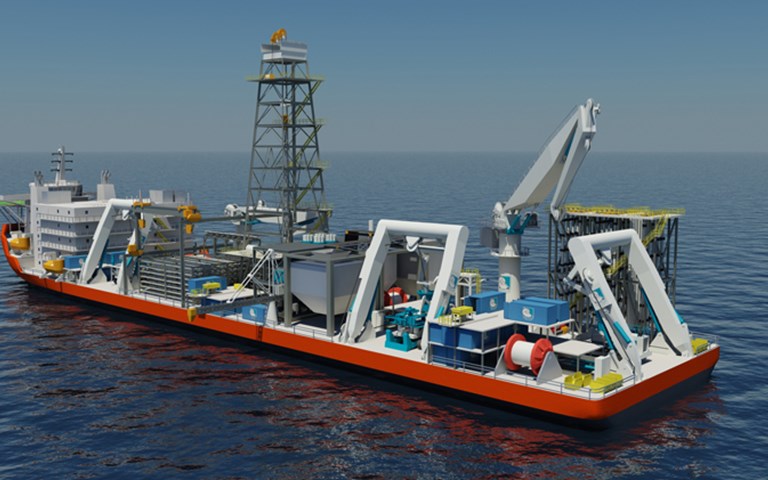Nautilus Minerals’ support vessel for its Solwara 1 project will measure 227 by 40 metres and accommodate up to 180 people as it mines for copper and gold along the bottom of the Bismarck Sea near Papua New Guinea. Courtesy of Nautilus Minerals
Nautilus Minerals is taking steps to develop a key component of its Solwara 1 project in the Bismarck Sea, northwest of Papua New Guinea, with the awarding of several contracts for its support vessel.
In late April, Nautilus awarded Siemens International Trading (Shanghai) Ltd. the contract for the vessel’s entire electrical installation, which company CEO Mike Johnston described as “an enormous amount of cabling and wiring.” The vessel will require 31 megawatts (MW) of power.
This is the latest in a recent spate of contracts to be awarded. Over the past five months, the company has announced, through the shipyard Fujian Mawei Shipbuilding, four long-lead-time contracts for its support vessel.
“It’s a good-quality vessel, we did a lot of due diligence on the shipyards,” said Johnston. “We’ve got a good mix, we think, of access to cheap [steel] in China but also marrying it up to the best in class for the specialist equipment.”
Solwara 1 will be the world’s first deep-sea mining project. It is a high-grade copper and gold project located 1,600 metres under water in the Bismarck Sea. The mine is expected to go into production in the first quarter of 2018. When it is in commercial production, Nautilus estimates it will produce about 1.3 million tonnes per year.
The project will make Nautilus the first company to mine the ocean floor for polymetallic seafloor massive sulphide deposits.
RELATED: Nautilus Minerals’ CEO Mike Johnston on deep-sea mining equipment
Three seafloor production tools – the auxiliary and bulk cutters and the collection machine – will cut ore from the seafloor and regularly feed it into a pump. The pump will bring the ore up to the support vessel through a riser pipe, where it will be dewatered. Clean water will return to the seafloor through the same pipe. The cutters and collection machine will be controlled from the vessel remotely.
Nautilus contracted Marine Assets Corporation to produce a vessel to its specifications, and the marine equipment provider has a further contract with Fujian Mawei. The vessel’s preliminary design work has been ongoing since halfway through 2014.
Rolls-Royce Marine of Norway received the first of the four recent contracts for the engines and thruster packages of the vessel’s dynamic positioning system in February. Computers will control the amount of power the thrusters put out, which will keep the vessel stationed within half a metre of its required location at all times.
Rolls-Royce’s new B33:45 engines will feature a Tier III-compliant selective catalytic reduction system to limit the vessel’s environmental impact. The system will control emissions by injecting a liquid-reductant through a special catalyst into a diesel engine’s exhaust stream.
“Deep sea mining is an exciting new industry,” John Knudsen, Rolls-Royce’s president of commercial marine, commented in a March press release. “We are very proud that the B33:45 generator sets have been selected to power this pioneering ship, which will be at the forefront of a whole new chapter in underwater exploration.”
The vessel will also include two cranes, one with active heave compensation, the contracts for which were awarded to MacGregor of Norway in early April. The heave-compensated crane uses a computer system that knows where the vessel is within half a metre in a three-dimensional space; as swells come through, the crane will automatically adjust the amount of wire to keep equipment in the same place and prevent jerking.
The vessel’s cargo handling equipment, awarded to Bedeschi SpA in Italy in March, will allow Nautilus to move the ore into the hull of the support vessel. From there, a conveyer belt system will transfer it to another boat to be sent back to shore for refining by Tongling Nonferrous Metals Group in China.
Nautilus has three major contracts left to award for the vessel’s derrick, dewatering plant and the integration of all the equipment into the vessel.
The seafloor production tools, built by Soil Machine Dynamics in the city of Newcastle upon Tyne in the United Kingdom, are 90 per cent complete and currently going through factory acceptance testing. They will be delivered by the end of 2015. The riser pipe, currently under construction, is expected to be delivered at the same time. The pump, constructed by GE Oil and Gas in Houston, Texas, is already complete and will be assembled and delivered in mid-2016.
“One of the advantages of getting delivery of the machine and the pump ahead of time is it allows us to do a lot of wet testing and testing of the machines to make sure that everything’s working as it should,” said Nautilus’ CFO, Shontel Norgate, “which will make that startup process a lot smoother than it otherwise could’ve been.”
According to Norgate, the company will not begin building the vessel until later in the year. It will be completely ready for early 2017, and then the remainder of that year will be spent on integration work.
The support vessel will measure 227 metres in length and 40 metres in width and will have accommodations for up to 180 people. Johnston said between 125 and 140 people are expected to be aboard when it is operating. It will be able to remain in the water at the site for five years before it has to be dry-docked.




